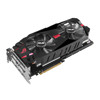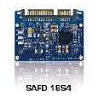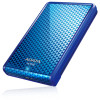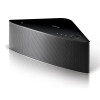
This year Nikon and Canon released 6Mpixel reflex cameras D100 and EOS D60 which have very similar technical characteristics and price. And we got a chance to compare these models in operation. The cameras were coupled with the SIGMA lenses of the identical optical design but with different bayonet mounts. The lens is of a really high class (marked as EX, Excellence), and we can expect that its contribution into image degradation is not determining; image quality depends mostly on the matrix - CCD of the Nikon and CMOS of the Canon. The matrices are almost equal in dimensions: 23.4 x 15.6 mm (3008 x 2000 pixels) of Nikon and 22.7 x 15.1 mm (3072 x 2048 pixel) of the Canon.
Today we will show you the shots taken simultaneously and express our impressions. But we understand that it will hardly affect the choice, because a decision to buy a certain camera is predetermined by the history of development of the manufacturers and experience and property of a photographer.

Focal length F=24 mm, aperture F:8, exposure 1/750 s, ISO 200. Original shots:
Nikon D100 (2.84 MB) and Canon EOS D60 (2.32 MB).
Development stages
We can't avoid a look into the past, that is why let's consider several stages of development of these two companies.
Nikon was founded in 1917, as a result of amalgamation of three firms one of which dated back to 1881. Before 1945 the company specialized mostly in military optical systems. In 1932 it released its first photo lenses. In 1936, or in 1937 according to other sources, it launched first lenses Nikkor 50 mm F: 3.5. They were installed on Hansa Canon cameras. So, these two companies intersected the first time 67 years ago.
In 1945 it had to cut down the number of plants from 19 to 1 and the workers from 23,000 to 1,400.
In 1948 they introduced the first rangefinder camera Nikon 1. It was an imitation of the legendary Leica and Contax, but a frame size of 24x36 mm was never a standard for Nikon, and in the first camera they set it to 24x32 mm.
In 1959 the company launched the first reflex camera Nikon F. This is a direct predecessor of our hero because the bayonet F used in that camera hasn't actually been changed. All old lenses can be installed into modern digital equipment, though they certainly don't have pins to transfer data and control the engines. Up-to-date lenses can also be mounted onto old cameras - our SIGMA lens for Nikon has a manual aperture adjustment ring and contacts to transfer aperture values from the camera. The similar lens for Canon supports only electrical aperture control.

Canon was founded in 1937 (the trade mark was registered in 1935), and the first camera named Kwanon was developed in 1934. In 1936 they tailored the above mentioned Hansa Canon with Nikon's lenses. The first camera with their own lens was Canon S1 in 1946. So, the companies entered the market with their own products (camera+lens) almost simultaneously.
The first reflex camera Canon F1ex appeared in 1959, like that of Nikon.
The Canon cameras got the EF bayonet in 1987. So, the Canon EOS D60 is a descendant of a much shorter branch than the Nikon D 100. But when analyzing possible sibling connections we should have a look at how the lenses are attached to these cameras. It's very important how to mount a lens and at what distance from a film. Traditionally in film cameras lenses are mounted with a thread or a bayonet.
Bayonet (derived from French baionnette) - a type of fastening in which a cylindrical member is inserted into a socket against spring pressure.
Another important parameter of the mount is a distance between the base
surface of the lens mount and a focal plane which is called flange focal
length. The flange focal length is 44 mm of the Canon EOS and 46.5 mm of
the Nikon with the bayonet F. Using adapting rings you can mount onto Canon
cameras a lot of third parties' lenses. At the same time, Nikon cameras
can be coupled with lenses with the flange focal length equal to 46.5 mm
or more. A suite of lenses can be much more expensive than a camera itself,
that is why a choice of a camera will be affected by optical systems available.
On the one hand, Nikon can adopt much more lenses from other firms. On
the other hand, if you are going to shoot both in a digital mode and onto
films, Nikon will be preferable, because with only two cameras (a film
camera can be quite old) it's possible to use all the optical devices without
adapting rings.
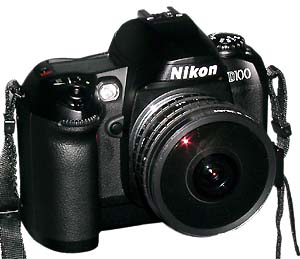 |
Nikon D100 with Peleng lens. |
Note that SIGMA, the Japanese company, whose lenses are an integral part of our tests was set up in 1961.
External examination
The cameras look very similar, but their controls are located differently. Thus, if the Canon has the dial above the release button, the Nikon has it under this button. The lens must be turned clockwise to be attached to one camera, and counter-clockwise to the other etc.

Nikon on the left, Canon on the right. The number of remaining shots is indicated on the Nikon's camera even when it's turned off.

Dimensions and weight of the cameras without the lens and batteries:
Canon -150 x 107 x 75 mm, 780 g, Nikon - 144 x 116 x 81 mm, 700 g.
Beside well-known differences inherited from film cameras such as flash
shoes, a mechanical remote control of the Nikon and an electronic one of
the Canon, there are differences in the body design caused by the digital
nature of the cameras.
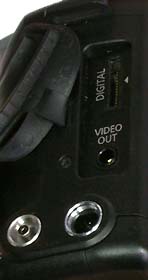 |
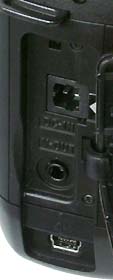 |
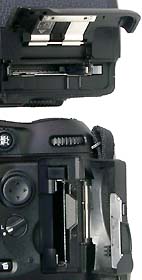 |
|
connectors: USB, video-out, flash sync, remote control. |
connectors: power supply, video-out, USB. |
Canon above, Nikon below. |
So, the Nikon's model has a protective cover for the LCD and a connector
for external power supply. Canon saved on it; to connect an external power
supply you must insert a special connector (in the form of a battery).
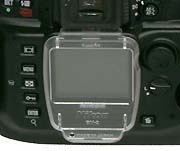 |
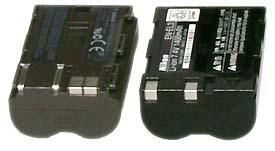 |
|
|
(7.4V, 1400 mAh) on the right, Lithium-Ion battery Canon BP-511 (7.4V, 1100 mAh) on the left. |

Canon 1.8" LCD of 114000 pixels, Nikon 1.8" LCD of 118000 pixels. In the Canon camera navigation is carried out with a dial on the back (this is a standard approach for film cameras), while in the Nikon's one it's done with a mini joystick typical of digital cameras.
By the way, a built-in flash of the Nikon rises much higher above the lens than that of the Canon, which is an advantage indeed. But the Canon has a standard synchronizer for unmatched flashes.
SIGMA lens (24-70 mm F:2.8 EX DG ASPHERICAL DF)
This up-to-date lens announced in 2001 consists of 14 elements three of which are used to minimize spherical aberration and astigmatism and made aspherical. It also uses two lenses made of low-dispersion glass which makes possible to eliminate chromatic aberration. The focal length can be changed from 24 to 70 mm at the constant aperture of F:2.8, by turning the ring. At the minimal focal length the lens juts out of the mount to the maximum. As the focal length increases, the lens gets shorter, and starting from about 65 mm the front lens protrudes again. Such to-and-fro motion certainly affects pressure on the ring.
Focusing can be automatic or manual. The mount incorporates a mechanism that locks the focusing ring in the auto mode. To shift to the manual mode move the ring toward you.
The lens is coupled with a shaped blend and the front lens doesn't move in case of focusing or zooming. It's very convenient when polarization filters are used, the thread for the color filters is 82x0.75. That is why for such lens which is positioned as professional and marked as EX (excellence) you will have to get quite expensive filters. The lens has a scale in meters and feet, the focal length of 24 mm has the depth resolution scale. The minimal focusing distance is 0.4 m. The aperture changes from F:2.8 to F:32 at all focal lengths. It measures 87x113 mm and weighs 700 g.
Photos
Look at the fragments of the above shot.
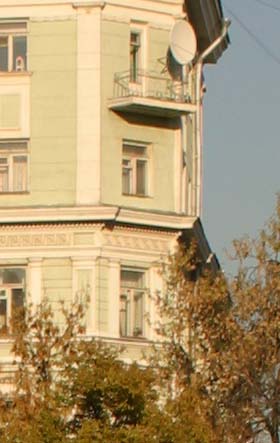 |
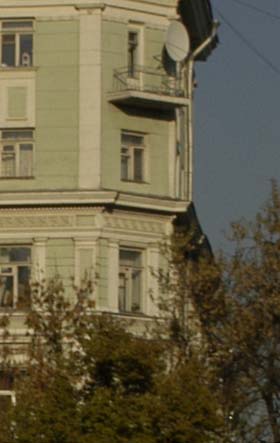 |
| Make - Canon | Make - NIKON CORPORATION |
| Model - Canon EOS D60 | Model - NIKON D100 |
| Orientation - 1 (top left) | |
| XResolution - 180 | XResolution - 300 |
| YResolution - 180 | YResolution - 300 |
| ResolutionUnit - 2 (inch) | ResolutionUnit - 2 (inch) |
| DateTime - 2002:10:14 16:20:49 | DateTime - 2002:10:14 12:21:13 |
| YCbCrPositioning - 1 (center of pixel array) | YCbCrPositioning - 2 (datum point) |
| ExifOffset - 196 | ExifOffset - 252 |
| ExposureTime - 1/750 seconds | ExposureTime - 10/7500 seconds |
| FNumber - 8.0000 | FNumber - 8.0000 |
| ISOSpeedRatings - 200 | |
| ExifVersion - 220 | ExifVersion - 220 |
| DateTimeOriginal - 2002:10:14 16:20:49 | DateTimeOriginal - 2002:10:14 12:21:13 |
| DateTimeDigitized - 2002:10:14 16:20:49 | DateTimeDigitized - 2002:10:14 12:21:13 |
| ComponentsConfiguration - 1 2 3 (YCbCr) | ComponentsConfiguration - 0 3 2 (CrCb) |
| CompressedBitsPerPixel - 3 (average) | CompressedBitsPerPixel - 4 (average) |
| ShutterSpeedValue - 1/1000 seconds | |
| ApertureValue - F 8.00 | |
| ExposureBiasValue - 0.0000 | ExposureBiasValue - -0.3333 |
| MaxApertureValue - F 2.80 | MaxApertureValue - F 2.83 |
| MeteringMode - 6 (partial) | MeteringMode - 2 (center weighted average) |
| Flash - 0 (no flash) | Flash - 0 (no flash) |
| FocalLength - 24 mm | FocalLength - 24.0000 mm |
| UserComment - | UserComment - ASCII |
| FlashPixVersion - 100 | FlashPixVersion - 010 |
| ColorSpace - 1 (sRGB) | ColorSpace - 1 (sRGB) |
| ExifImageWidth - 3072 | ExifImageWidth - 3008 |
| ExifImageHeight - 2048 | ExifImageHeight - 2000 |
| InteroperabilityOffset - 1866 | InteroperabilityOffset - 38228 |
| FocalPlaneXResolution - 3443.9462 | |
| FocalPlaneYResolution - 3442.0168 | |
| FocalPlaneResolutionUnit - 2 | |
| SensingMethod - 2 (other) | |
| FileSource - 3 (digital still camera) | FileSource - 768 (other) |
| Maker Note (Vendor): - | Maker Note (Vendor): - |
| Macro mode - Normal | |
| Self timer - Off | |
| Quality - Fine | |
| Flash mode - Off | |
| Sequence mode - Single or Timer | |
| Focus mode - One-Shot | |
| Image size - Large | |
| Easy shooting mode - Manual | |
| Digital zoom - None | |
| Contrast - Normal | |
| Saturation - Normal | |
| Sharpness - Normal | |
| Metering mode - Partial | SensingMethod - 2 (other) |
| Focus type - Auto | |
| AF point selected - Center | |
| Exposure mode - Av-priority | ExposureProgram - 3 (aperture priority) |
| White Balance - Auto | LightSource - 0 (auto) |
| Image Type - IMG:EOS D60 JPEG | |
| Firmware Version - Firmware Version 1.0.2 | Software - Ver.1.01 |
| Camera Serial Number - 13AF65312 | |
| Image Number - 1898955 | |
| Owner Name - RWPBB | |
| SubsecTime - 909115392 | |
| SubsecTimeOriginal - 909115392 | |
| SubsecTimeDigitized - 909115392 | |
| SceneType - 256 (other) |
Let's compare data on the shots given by the IrfanView program and the shots themselves. To make the comparison easier we changed the order of parameters for the Nikon's model. As you can see, there is less information on the Nikon's shots. Although Canon doubles some data, there is still more useful information.
Unfortunately, Nikon marks information on sensitivity so that neither IrfanView nor XP can see it. But the Nikon View 5 provides all useful information including sensitivity.
In case of Canon, the exposure time doesn't match with the shutter speed. It's interesting that the XP gives both the values equal to 1/750 s.
As the table indicates, in both cameras a lot of attention is paid to identification of a shot and associating with a certain camera. Owner Name is recorded into the Canon EOS D60 camera's memory with the RemoteCapture program.
Below in the table is information on shots which can be obtained with the camera's own viewing programs. They don't say much about other shots and can't be used as universal. The Zoom Browser EX can copy data into the clipboard. From the Nikon View 5 you are to retype information manually.
Zoom Browser EX
| File Name: IMG_8955.jpg
Camera Model: Name Canon EOS D60 Shooting Date/Time: 14.10.2002 16:20:49 Shooting Mode: Aperture-Priority AE Tv( Shutter Speed ): 1/750 Av( Aperture Value ): 8.0 Metering Mode: Partial Exposure Compensation: 0 ISO Speed: 200 Lens: 24.0 - 70.0mm Focal Length: 24.0mm Image Size: 3072x2048 Image Quality: Fine Flash: Off White Balance: Auto AF Mode: One-Shot AF Active AF Points [ Center ] |
File Name: DSC_0012.JPG
Camera Model Name: NIKON D100 Shooting Date/Time: 14.10.2002 12:21:13 Tv( Shutter Speed ): 1/750 Av( Aperture Value ): 8.0 Exposure Compensation: -0.333333 Image Size: 3008x2000 Flash: Off File Size: 2915KB Owner's Name: |
| Parameters
Contrast: Normal Sharpness: Normal Color saturation: Normal Color tone: Normal File Size: 3067KB File Number: 189-8955 |
|
| Custom Function Settings
02:Shutter button/AE lock button 0:AF/AE lock 03:Mirror lockup 0:Disable 04:TV,AV and exposure level 0:1/2-stop 05:AF-assist beam/Flash firing 0:Emits/Fires 06:Shutter speed in Av mode 1:1/200(fixed) 07:AEB sequence/auto cancellation 0:0 Enabled 08:Shutter curtain sync 0:1st-curtain sync 09:Lens AF stop button Fn, switch 0:AF stop 10:Auto reduction of fill flash 0:Enable 11:Menu button return position 0:top 12:SET button func, when shooting 0:Default 13:Sensor cleaning 0:Disable 14:Superimposed display 0:On 15:Shutter release without CF card 0:Possible without CF card |
|
| Drive Mode: Single-frame shooting
Owner's Name: RWPBB Camera Body: No. 0330301216 |
Nikon View 5
| Canon EOS D60
2002/10/14 16:20:49 Image Size: 3072 x 2048 Focal Length: 24.0 mm Exposure Mode: Metering Mode: Partial 1/750 sec - f/8 Exposure Comp.: 0 EV Sensitivity: White Balance: |
Nikon D100
2002/10/14 12:21:13.6 JPEG (8-bit) Fine Image Size: Large (3008 x 2000) Lens: 24.0 - 70.0mm f/2.8-2.8 Focal Length: 24.0 mm Exposure Mode: Aperture Priority Metering Mode: Center-Weighted 1/750 sec - f/8 Exposure Comp.:-0.3 EV Sensitivity: ISO 200 White Balance: Auto AF Mode: AF-S Tone Comp: Auto Flash Sync Mode: Not Attached Color Mode: Mode II (Adobe RGB) Hue Adjustment: 0 Sharpening: Auto Noise Reduction:OFF Image Comment: |
I purposely give you so much formal information on the shots as the shots look different despite equal aperture, exposure and sensitivity. It seems that high sensitivity of Nikon is measured in different units, and if we take into account the data of an independent exposure meter, the shots made by Nikon D100 will look like underexposed. Its own exposure meter understands that and in our case of manual settings it indicated a correction of -0.3EV. Sensitivity is defined in ISO only for classical photo materials, and an exposure index of digital cameras is introduced only for the sake of separate exposure meters.
The color balance in the auto mode is also quite original; looking at the leaves I have an impression that the shot was made in summer, not in autumn.
As to the Canon and information on the shots given by the IrfanView, there are some interesting items - FocalPlaneXResolution - 3443.9462, FocalPlaneYResolution - 3442.0168, which give us a physical matrix size of 0.883"x0.595" = 22.4x15.11 mm.
When estimating a size of possible printouts, Canon is guided by an actual printing resolution (screen line number) of 180 lpi, while Nikon by photographic quality of sublimation filters.
As you can see from the shots of the resolution charts, the cameras
have equal resolutions, though with the equal exposure, aperture and sensitivity
the Nikon's shot looks darker. The shots of reflection of the slot lying
on the table with luminescent lamps, in the gitter, makes possible to compare
spectral sensitivity. Although the luminescent lamps have a band spectrum,
the spectral characteristics of the matrices can be considered equal.
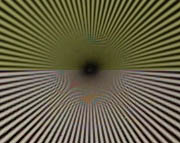 |
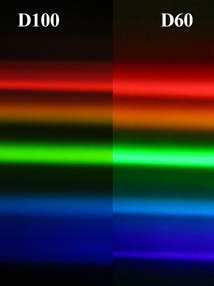 |
|
F=24 mm, F:8, 1/20 s, ISO 200. The picture is twice enlarged. |
|
Dependence of the contrast transfer function on a distance from the frame's center entirely depends on the lens, at F:8 it's hardly noticeable and at F:2.8 it becomes more pronounced. For quantitative estimation we made a shot of a resolution chart made of several rows of vertical black strokes drawn at a different frequency. Amplitudes for the row consisting of 400 pairs of lines were correlated with the respective values of the row consisting of 100 black strokes. For the frame center the ratio is 1.05, and for the edges it makes 0.84. In the center the thin lines are more contrast than the thick ones. Probably, it's connected with the sharpness algorithm and compression in the JPEG format.
And finally there are some more fragments of photos; click to get the originals.

Canon
ISO 200; F=70 mm; F:2.8; 1/500 s

Nikon
ISO 200; F=70 mm; F:2.8; 1/320 s
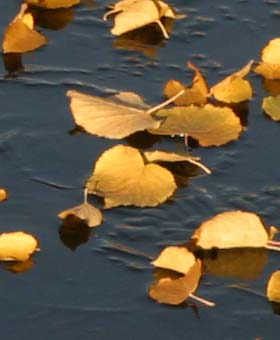 |
 |
|
ISO 200; F=70 mm; F:8; 1/250 s |
ISO 200; F=70 mm; F:8; 1/180 s |

Canon
ISO 200; F=70 mm; F:2.8; 1/180 s

Nikon
ISO 200; F=70 mm; F:2.8; 1/160s
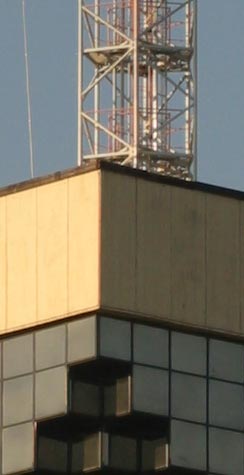 |
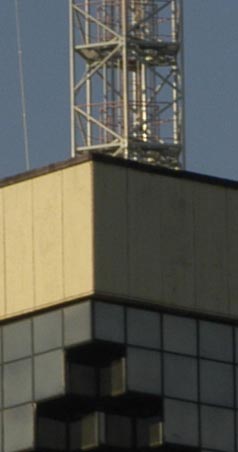 |
|
ISO 200, F=70 mm, F:11, 1/250 s |
ISO 200, F=70 mm, F:11, 1/250 s |
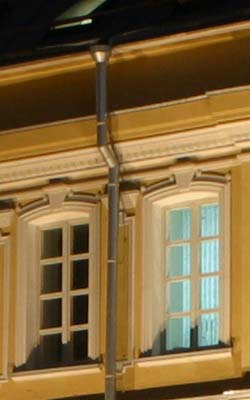 |
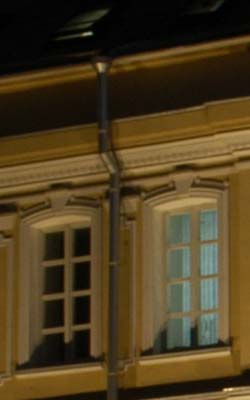 |
|
ISO 200; F=24 mm; F:11; 1.5 s |
ISO 200; F=24 mm; F:11; 1.6 s |
The shots made by V. Rodionov and S.Sherbakov.
To get more detailed information on the controls of the Nikon D100 camera
and how a noise level depends on sensitivity go to the Part
II of the article written by S.Sherbakov.
Write a comment below. No registration needed!







